

Racetrack premiere for the SLS AMG GT3 on the Nürburgring “Nordschleife”
Nürburgring – The new Mercedes-Benz SLS AMG GT3 made its first racing appearance for the 4-hour race held on 25 September 2010 as part of the VLN Nürburgring Endurance Championship. Even though the gullwing car was already involved in an accident during the starting lap, Bernd Schneider and Thomas Jäger were able to demonstrate the potential of the SLS AMG GT3. Developed according to the GT3 regulations of the FIA (Fédération Internationale de l’Automobile), the SLS AMG GT3 was entered in prototype class E1-XP. A total of 206 cars took part in this eighth VLN race.

Having achieved a third place in qualifying, the SLS AMG GT3 started the race from the second rank bearing start number 738. Bernd Schneider, five-time DTM Champion and now an AMG brand ambassador, was behind the wheel at the start. Schneider was already in second place by the first bend, however contact with the leading car on the second bend caused him to spin and collide with the following car. After a 25-minute break for repairs, Bernd Schneider returned to the race three laps behind the leaders, and was able to hold his own without problems in the lineup of GT3 cars.
When Thomas Jäger replaced Bernd Schneider at the wheel, the SLS AMG GT3 continued the race according to expectations. When the race was ended prematurely owing to numerous accidents, the gullwing was positioned in 91st place, three laps behind.
Bernd Schneider: “I think that despite my accident during the starting lap, we were able to show the potential of the gullwing. The SLS AMG GT3 feels great, and makes very satisfactory lap times possible. Even on the demanding North Loop at Nürburgring, the car drives very well.”

Thomas Jäger: “Today’s race was a valuable test, and provided important data for the planned further development of the SLS AMG GT3. We will use the findings obtained today to fine-tune the car, so that we are well prepared for the next VLN race.”
With five DTM titles, one ITC championship and one FIAFIA GT championship to his name, Bernd Schneider (46) is one of the most successful German racing drivers. Thomas Jäger (33) is the reigning Porsche Carrera Cup (Germany) champion, and drove in the DTM for Mercedes-Benz between 2000 and 2003. This season he is lining up in the ADAC GT-Masters (Germany). Like Bernd Schneider, he is a member of the instructor team at the AMG Driving Academy.
First racing appearance as part of the development and test programme
This first racetrack appearance of the SLS AMG GT3 at the VLN event (VLN = Association of Nürburgring Endurance Cup Organisers, with 10 motorsport clubs) on 25 September 2010 was a fixed part of the development and testing programme which commenced in June 2010. The four-hour race on the legendary old “Nordschleife” (“North Loop”) of the Nürburgring Grand Prix circuit, was intended to test the gullwing model under realistic racing conditions.

The focus was not only on fast lap times, but also on the durability of all components, service-friendliness and smooth procedures during pitstops and driver changes. During this race on the 20.8-kilometre long Nürburgring “Nordschleife” – which is acknowledged to be the world’s most demanding racetrack – the chosen suspension setup was assessed under racing conditions for the first time.
The VLN Nürburgring Endurance Championship has created a loyal following for itself with a wide variety of competitors, easily accessible paddocks and low entry prices. The colourful lineup, with different vehicle models ranging from near-series compact cars to recent classics and right up to thoroughbred super-sports cars, guarantees fast-changing and exciting races. Depending on the event, around 200 racing cars can be at the starting line.

Cooperation between AMG and HWA AG
The racing version of the SLS AMG is being developed and produced by AMG in close cooperation with HWA AG. The HWA team is one of the most successful in international motorsport, as shown by nine driver championships in the DTM and ITC, as well as two championship titles in the FIA GT Championships. No other brand has won as many DTM races and DTM titles as AMG-Mercedes.
Interested racing teams can enter the new SLS AMG GT3 in all race series under the FIA GT3 regulations, for example the FIA GT3 European Championship, the ADAC GT-Masters, the VLN Endurance Championship and the 24-hour races at the Nürburgring or Spa-Francorchamps (Belgium).

Orders for the SLS AMG GT3 placed directly with Mercedes-AMG
Orders can be placed directly with Mercedes-AMG GmbH. The sales price is € 334,000 (net)/€ 397,460 (incl. 19% VAT). The vehicle is only available with left-hand drive. Deliveries commence in February 2011, following homologation by the FIA in accordance with the GT3 regulations.





